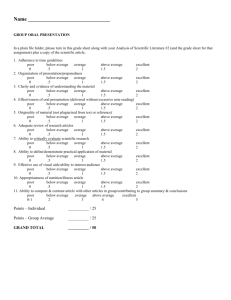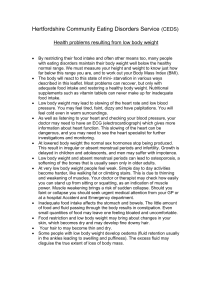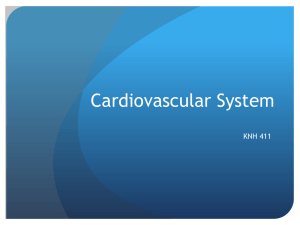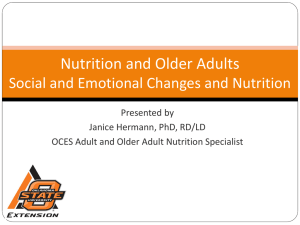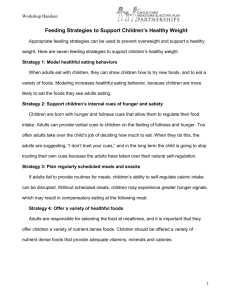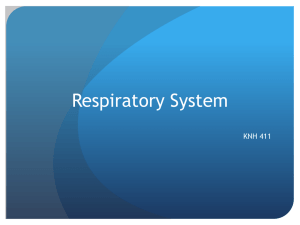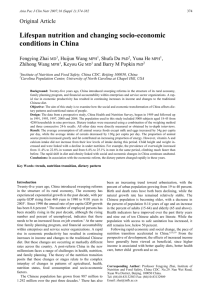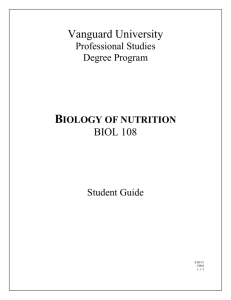Nutrition through the Lifecycle: Childhood to Late Adulthood
advertisement
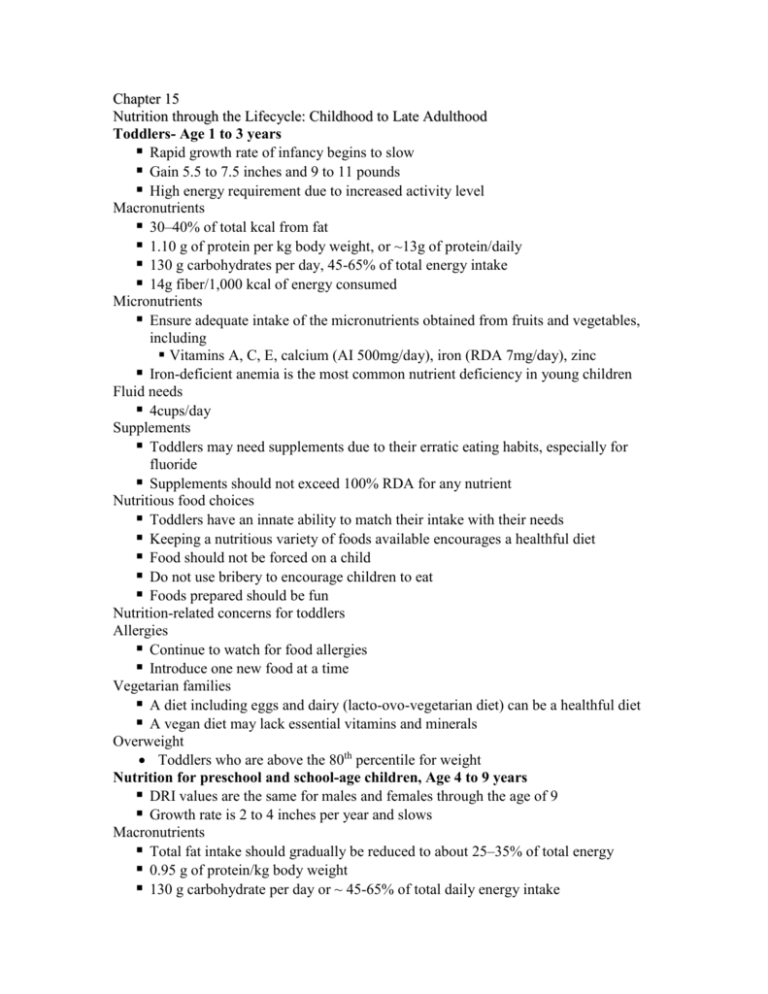
Chapter 15 Nutrition through the Lifecycle: Childhood to Late Adulthood Toddlers- Age 1 to 3 years Rapid growth rate of infancy begins to slow Gain 5.5 to 7.5 inches and 9 to 11 pounds High energy requirement due to increased activity level Macronutrients 30–40% of total kcal from fat 1.10 g of protein per kg body weight, or ~13g of protein/daily 130 g carbohydrates per day, 45-65% of total energy intake 14g fiber/1,000 kcal of energy consumed Micronutrients Ensure adequate intake of the micronutrients obtained from fruits and vegetables, including Vitamins A, C, E, calcium (AI 500mg/day), iron (RDA 7mg/day), zinc Iron-deficient anemia is the most common nutrient deficiency in young children Fluid needs 4cups/day Supplements Toddlers may need supplements due to their erratic eating habits, especially for fluoride Supplements should not exceed 100% RDA for any nutrient Nutritious food choices Toddlers have an innate ability to match their intake with their needs Keeping a nutritious variety of foods available encourages a healthful diet Food should not be forced on a child Do not use bribery to encourage children to eat Foods prepared should be fun Nutrition-related concerns for toddlers Allergies Continue to watch for food allergies Introduce one new food at a time Vegetarian families A diet including eggs and dairy (lacto-ovo-vegetarian diet) can be a healthful diet A vegan diet may lack essential vitamins and minerals Overweight Toddlers who are above the 80th percentile for weight Nutrition for preschool and school-age children, Age 4 to 9 years DRI values are the same for males and females through the age of 9 Growth rate is 2 to 4 inches per year and slows Macronutrients Total fat intake should gradually be reduced to about 25–35% of total energy 0.95 g of protein/kg body weight 130 g carbohydrate per day or ~ 45-65% of total daily energy intake 14 g fiber/1,000 kcal of energy consumed Micronutrients Vitamins and minerals from fruits and vegetables continue to be a concern Vitamins A, C, E, calcium, iron, zinc Large increases in the DRIs compared to toddlers as they get older Fluid 5-8 cups/day Supplements May be recommended when particular food groups are not eaten regularly Supplements should be appropriate for the child’s age Nutritious food choices The effect of school attendance on nutrition o Public schools offer low-or no-cost school breakfasts to help children optimize their energy intake. o Few school lunch programs meet the new dietary guidelines o Student choices tend to be higher in fat than federal guidelines suggest o Some schools have fast-food restaurants competing with the school lunch program Parents can teach children about healthful food choices Some foods “help us grow healthy and strong” Some foods are better used as occasional treats Overweight children are at greater risk of becoming overweight adults. Nutrition for older children and Adolescents – ages 9-18 Growth spurts occur during childhood and adolescence Adult half of peak bone mass is deposited during adolescence. Body composition and weight change dramatically They begin to make their own food choices Activity levels highly vary Macronutrients 25%–35% of total energy from fat, or no more than 10% of total energy from saturated fat sources 0.85 g protein/kg body weight RDA for carbohydrates is 130 g/day, or 45-65% of total energy intake AI for fiber for adolescents is 26g/day Micronutrients Micronutrient needs rise sharply as children approach puberty Meeting the needs for calcium and vitamin D intakes are critical to achieve peak bone density Iron are very important Vitamin A is critical to support the rapid growth and development that occur during adolescence Fluid Adequate Intake (AI) of fluids varies by gender, ranging from 8 cups for girls and 11 cups for boys Supplements A vitamin/mineral supplement supplying no more than 100% of the daily values may be warranted Nutritious food choices Healthy role models, such as athletes, can be used to encourage good choices Most adolescents’ diet is a lack of vegetables, fruits, and whole grains Nutritious food choices Peer influences and fast-paced lifestyle can lead adolescents to choose fast foods Parents can act as role models and keep healthful food choices available Adequate intake of fruits, vegetables, and whole grains should be encouraged Nutrition related concerns Adequate physical activity is very important in reducing obesity Disordered eating and eating disorders can begin in these years Hormonal changes may trigger adolescent acne Cigarette smoking, alcohol, and illegal drugs can also have an impact on nutrition and health Nutrition for Older Adults Physiologic changes to the bodies of older adults, age 65 years and older, include Decreased muscle and lean tissue Increased fat mass Decreased bone density Decreased immune function Impaired absorption of nutrients Taste and smell perception is often diminished Macronutrients Energy needs usually decrease due to reduced activity levels and lower lean body mass Recommendations for fat (within 20-35% of total energy intake, and no more than 10% of total energy from saturated fat), carbohydrate (130g/day of complex carbohydrates), and proteins (.80g/kg body weight per day) Fiber recommendation for those age 50 are 30g/day for men and 21g/day for women Micronutrients Calcium and vitamin D requirements increase due to poor calcium absorption Iron needs decrease with ageing Zinc intake should be maintained for optimizing immune function and wound healing. Vitamin C and E recommendations are the same for all adults Adequate intake of B-complex vitamins is a special concern B12 absorption decreases with age Vitamin A requirements are the same, but older adults absorb higher amounts and they might be at risk of toxicity Fluid AI 13 cups/day Nutrition related concerns Many chronic diseases are more prevalent in overweight or obese adults Underweight may result from illness, disability, loss of sense of taste or smell, depression, social isolation Dental health issues may cause older adults to avoid meats, firm fruits, and vegetables Age-related eye diseases are responsible for vision impairment and blindness in older adult Macular degeneration Cataract Antioxidants and Phytochemicals may prevent and protect against eye disorders. Some medications can alter nutrient absorption or decrease appetite Alcohol abuse Financial and mobility problems Financial Problems 6–7% of households with older Americans experience food insecurity. Food insecurity means they are unable to obtain enough food to meet their needs every day. Food Stamp Program Child and Adult Care Program Commodity Supplemental Food Program Senior Farmer’s Market Nutrition Program Nutrition Services Incentive Program
